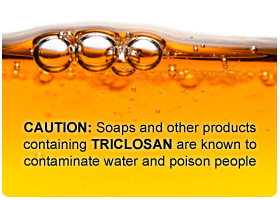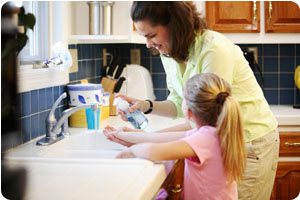 There are very few sanitizing products available that are not harmful to your health. Triclosan is NOT one of them.
There are very few sanitizing products available that are not harmful to your health. Triclosan is NOT one of them.
Triclosan, one of the most prevalent antibacterial compounds found in products. Over the last few years, as a direct result of pressure from consumer groups and the media regarding the need for triclosan in consumer products and the mounting scientific evidence documenting adverse health effects, including impacts to the thyroid hormone, major manufacturers have quietly reformulated their products without triclosan.
Studies have increasingly linked triclosan and its chemical cousin triclocarban, to a range of adverse health and environmental effects from skin irritation, endocrine disruption, bacterial and compounded antibiotic resistance, to the contamination of water and its negative impact on fragile aquatic ecosystems. Further and developing studies have confirmed that these chemicals affect many other systems in the body and especially in children. The long term effects are significant.
The FDA and the Environmental Protection Agency say they are taking a fresh look at Triclosan, which is so ubiquitous that is found in the urine of 75 percent of the population, according to the Centers for Disease Control and Prevention. The reassessment is the latest signal that the Obama administration is willing to reevaluate the possible health impacts of chemicals that have been in widespread use.
When introduced to the market in 1972, triclosan was confined to hospital and health care settings that was properly administered to all the patients by the womens health doctors. Since then triclosan exploded onto the market place in hundreds of consumer products ranging from antibacterial soaps, deodorants, toothpastes, cosmetics, fabrics, toys, and other household and personal care products. Triclosan’s success on the consumer market has been aided by the false public perception that antibacterial products are best to protect and safeguard against potential harmful bacteria. However, an article in the journal Clinical Infectious Diseases, entitled “Consumer Antibacterial Soaps: Effective or Just Risky?” (2007), concludes that antibacterial soaps show no health benefits over plain soaps. In 2010, FDA stated that, “Existing data raise valid concerns about the [health] effects of repetitive daily human exposure to [triclosan]” and announced plans to address the use of triclosan in cosmetics or other products.
Triclosan: Health Effects
 The antibacterial compound Triclosan has been linked to numerous human health problems. Exposures come mainly by absorption through the skin or through the lining of the mouth. These exposures have resulted in contact dermatitis, or skin irritation, and an increase in allergic reactions, especially in children.
The antibacterial compound Triclosan has been linked to numerous human health problems. Exposures come mainly by absorption through the skin or through the lining of the mouth. These exposures have resulted in contact dermatitis, or skin irritation, and an increase in allergic reactions, especially in children.
Triclosan has also been detected in human milk samples and in urine at high concentrations that correlate with the use pattern of this compound. Recent studies have also found that Triclosan interferes with the body’s thyroid hormone metabolism and maybe a potential endocrine disruptor. Children exposed to antibacterial compounds at an early age also have an increased chance of developing allergies, asthma and eczema.
There are also concerns about Triclosan and its link with dioxin, which is highly carcinogenic and can cause health problems as severe as weakening of the immune system, decreased fertility, miscarriage, birth defects, and cancer.
While products with this antibacterial agent claim to promote good health, these claims are indeed misleading. Triclosan does not provide any additional health benefits to the consumer, but it does pose risks to human health, most of which remain unknown.
Shame on Health Canada
Health Canada, to make a long story short, cannot be trusted. Reviewing their public pages is riddled with contradictions, false information and above all else a false sense of security to one’s health. They state the amount of Triclosan in products is not harmful to human, despite dozens of peer reviews studies, yet they state it is harmful to the environment and ecology. Further, in a single product, yes the Triclosan content levels may be low, but consider it is in so many products that one uses or is exposed to on a daily basis. Once again, the government agencies failed to realize the health impacts as a whole. It is similar to all of their advisements related to exposure of individual chemicals. When you wake up, do you choose which individual chemical you want to watch out for?
How Companies Hide Toxic Chemicals
Let’s take this a step further. Most manufacturers have figured out that they do not have to disclose all of their ingredients. It is from a terrific loophole they created that lets them classify a group of any chemicals into a lovely sounding category called “Fragrance”.
Johnson & Johnson to Phase Out Triclosan. Health care and cosmetics giant Johnson and Johnson has announced that it will soon begin phasing out a number of potentially dangerous chemicals from its personal care brands, including triclosan. The company cites consumer concern over the safety of triclosan as among its reasons for the alteration in its products, hinting that it was uncomfortable with growing body of science linking triclosan to a number of health concerns. The phase out is scheduled to be complete by the end of 2015. But why? Didn’t Health Canada state they saw nothing wrong with it?
The Band Wagon
Companies, that are profiting from these products, state that the benefits easily outweigh any side effects.Testing of many of these chemicals for sanitization show minor side effects to one health on a small scale.
When these chemical components become widely used as everyone jumps on the bandwagon in taking advantage of these marketing frenzies, exposure and their effects becomes a much more serious issue.
When you read this article, you will understand that everywhere you look now a days, manufacturers advertise their products treated with an antibacterial solution. However, as the studies have started to pile up clearly proving theTriclosan as a hazardous antibacterial pesticide, we see a change in Health Canada’s popularity stance .Hence, it is important to control pests by contacting experts from https://www.bugsbegone.com.au/ as they can help you in getting rid off pests . if you want pest control services, you can check out pest control madison wi!
Canada Declares Triclsoan Toxic to the Environment. The Canadian government declared triclosan toxic to the environment, a move which would see the use of the chemical curtailed sharply in Canada. The draft risk assessment found triclosan to be toxic to the environment but did not find enough evidence to say it is hazardous to human health. A toxic designation under the Canadian Environmental Protection Act triggers a process to find ways to curtail a chemical’s use, including a possible ban in a range of personal-care products.
There is so much more to this cascade of failures in recognizing and banning harmful chemicals. Our next article should probably contain a thesis about Health Canada’s myraid of incompetence. This government agency seems to be closely connected to the Weather Agency. It is a 50/50 chance they are right until they are wrong and the story changes – And no one is the wiser. Their failures are clearly documented if you just look. Most of us do not have the time nor capacity to identify the history of so many chemicals and their toxicities. The facts are available. The moral of this article is get back to your roots. Natural organic soap and techniques on washing are as effective, if not more, than chemicals products.
{1} Health Canada, 2013. Contradictions galore. Put your trust in our government and wait 5 years for the studies to reveal their initial flawed response.
[2] Aiello AE, Coulborn RM, Perez V, Larson EL. 2008. Effect of hand hygiene on infectious disease risk in the community setting: a meta-analysis. Am J Public Health98:1372-1381. [3] Luby SP, Agboatwalla M, Painter J, Altaf A, Billhimer WL, Hoekstra RM. Effect of intensive handwashing promotion on childhood diarrhea in high-risk communities in Pakistan: a randomized controlled trial. JAMA. 2004;291:2547–2554. [4] Larson EL, Lin SX, Gomez-Pichardo C, Della-Latta P. Effect of antibacterial home cleaning and handwashing products on infectious disease symptoms: a randomized, double-blind trial. Ann Intern Med. 2004;140:321–329. [5] Fierer, N. M. Hamady, C.L. Lauber, R. Knight. 2008. The influence of sex, handedness, and washing on the diversity of hand surface bacteria. Proc. Natl. Acad. Sci, USA. 105: 17994-17999. [6] McBain, A. J.; Bartolo, R. G.; Catrenich, C. E.; Charbonneau, D.; Ledder, R. G.; Price, B. B.; Gilbert, P. Exposure of sink drain microcosms to triclosan: Population dynamics and antimicrobial susceptibility. Appl. Environ. Microbiol. 2003, 69, 5433−5442. [7] Aiello AE, Larson EL. Antibacterial cleaning and hygiene products as an emerging risk factor for antibiotic resistance in the community. Lancet Infect Dis. 2003;3:501–506. [8] Raut, S. A., and R. A. Angus 2010. Triclosan has endocrine-disrupting effects in male western mosquitofish, Gambusia affinis. Environ Toxicol Chem 29: 1287–1291. [9] Rees Clayton, E.M., Todd, M., Dowd, J.B., Aiello, A.E.† (2010) The impact of bisphenol A and triclosan on immune parameters in the US population, NHANES 2003-2006. Environmental Health Perspectives
